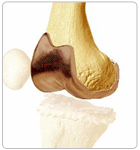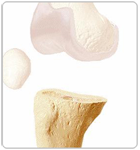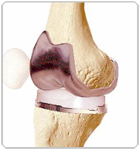Knee Joint Replacement Overview & Description

All You Wanted To Know About Knee Replacement
With increase in longevity, more number of senior citizens demand a better quality of life. A painful knee can seriously hamper a person's capacity to walk freely and make him dependent not only on drugs to relieve pain but also on others for mobility. The solution to painful arthritic knee is now easily available in form of Knee Surface Replacement.
Imagine yourself pushing a fully loaded vehicle which has flat tyres. You would need considerable force to make it move. Same happens to an overweight person with an Arthritic Knee Joint. Their knee joints feel stiff and are deformed and hence the person needs more physical energy to get up from a sitting position, walk, climb stairs and negotiate slopes.
To overcome this, he or she takes medicine to relieve pain and muscle spasm and may use a support to walk, but as the age advances, the ability to overcome pain decreases making the person confined to bed most of the time. Prolonged use of NSAIDS (pain relieving medicines) can even damage the liver and the kidneys of the elderly person.
For any individual, irrespective of age, having painful knee joints which hamper day to day living, knee surface replacement is an ideal choice. With current state of progress in every field of medicine, conditions like diabetes, hypertension, cardiac insufficiency are no more contraindications for surgery. Even obesity is not a problem.
The surgery is relatively safe since it is carried out under Epidural Anaesthesia. This anaesthesia is better tolerated by the elderly. There is also an added advantage of postoperative analgesia by use of infusion pump. The infusion pump is used to deliver the calculated fractional dose suitable for an individual patient.
The patient is constantly monitored with the Pulse Oxymeter to measure the Oxygen concentration of blood and Cardioscope to evaluate cardiac function during the surgery.
Unlike Hip Joint Replacementwhere a large part of the upper end femur is removed to be replaced by metallic implant, in Knee Surface Replacement only the irregular superficial surface of femoral and tibal condyles are shaved, which are then resurfaced using cobalt chrome prosthesis for the femur the tibia with an Ultra High Molecular Weight High Density Polyethylene (UHMWHDPE) insert for the tibia and patella, as this combination of metal and plastic has minimum friction and is well tolerated by the body.
Even though the surgery involves bone resurfacing, it mainly consists of soft tissue realignment and balancing, hence the deformity is corrected and the patient is ready to be discharged on the 5th postoperative day in majority of cases. This reduces the cost as well social inconvenience to the family.
Resurfacing reduces the friction thereby reducing the pain and hence the patient starts exercise and starts standing and walking either on the same day or next day, initially requiring support for locomotion. During the post operative period at home, the patient needs to exercise regularly, use walking aids and use a commode. Sitting on the floor is not permitted. Unlimited stair climbing and walking is permitted.
Knee Replacement Surgery is One Of The Most Successful Procedures Used For Relief Of Pain,Gaining The Range Of Motion And improving The Ability To Walk,For A Variety Of Painful Knee Disorders.sss
If you are advised knee replacement surgery, it is natural that you would want to know more about it. This website gives you all the information, which you wish to know, It explains, in simple words, what to expect before, during and after the surgery. It is meant to help you understand the intricacies of this complex surgery. In simple language, you are told what will be done for you by the medical and paramedical staff and what you are required to do to achieve the desired end result. It is recommended that you go through this website before you undergo the surgery. If you have any questions, please use the feedback form and we would be glad to help.
The schedule given here is a guideline and individual variations may occur. The end result varies in different individuals, and in two operated knees in the same individual, depending on various factors like age, general condition of the patient, conditions of the joint, indication for surgery, whether the surgery is on single knee or both knee joints simultaneously etc.
No guarantee of any kind can be given for any surgical procedure. According to world reports, Knee Replacement Surgery is one of the most successful procedures used for relief of pain, gaining the range of motion and improving the ability to walk.
Every surgery carries certain risks. You are required to make yourself familiar with these risks and their shortcomings.
Dr Niraj Vora opines that, knee pain is a common complaint that has many causes. Determining what is the cause of your knee pain, symptoms may be straight forward, or it may require special tests to make a diagnosis. Once the Cause of your knee paincan be determined, appropriate treatment can begin.








